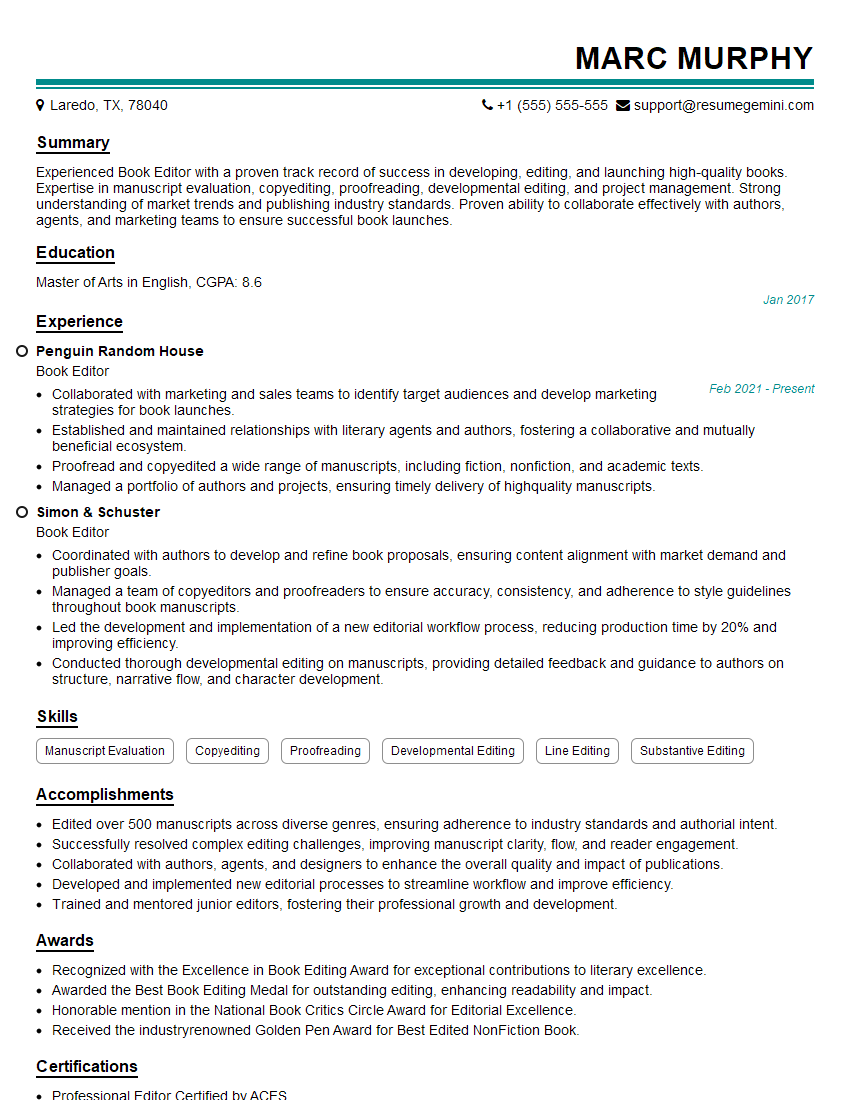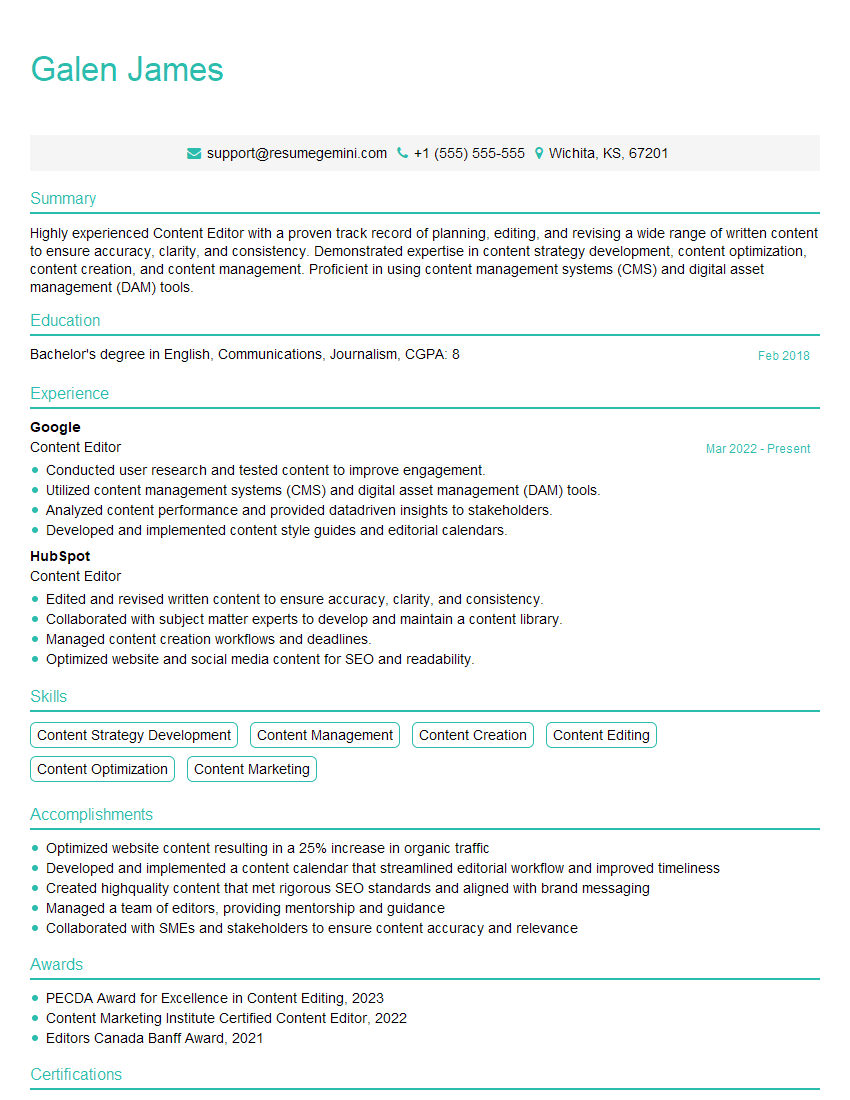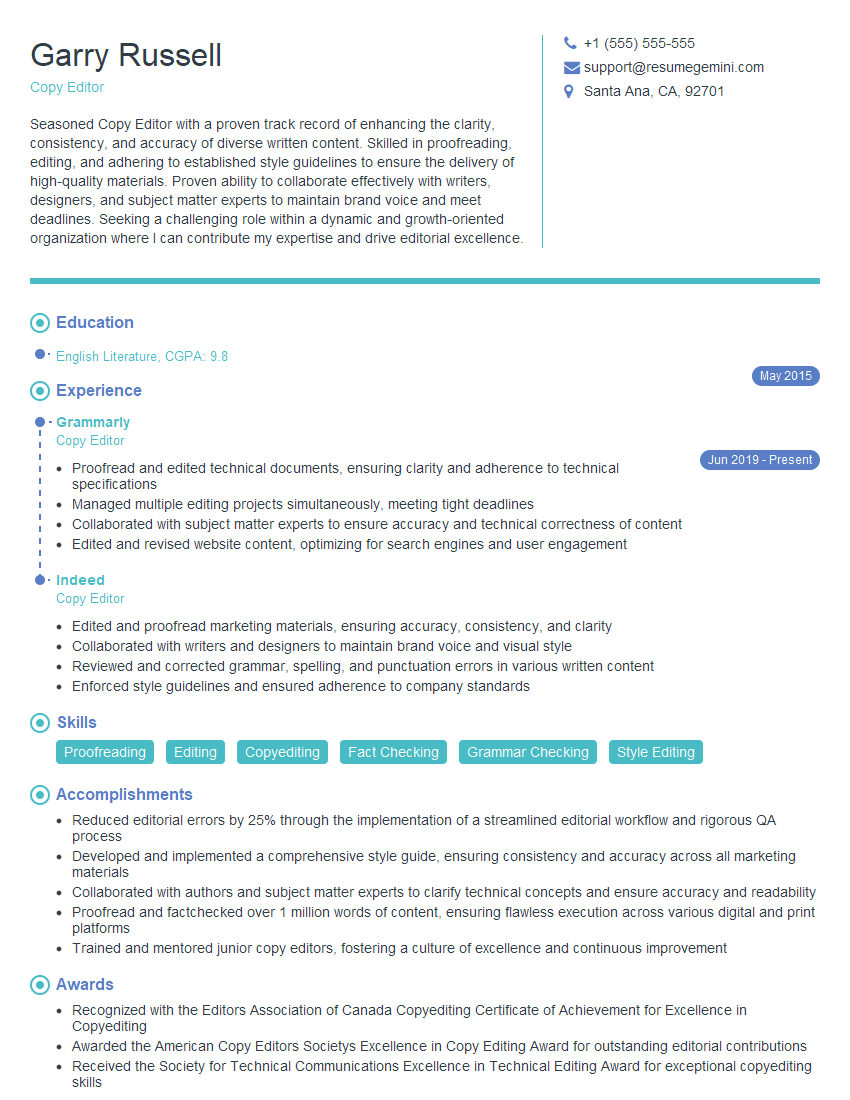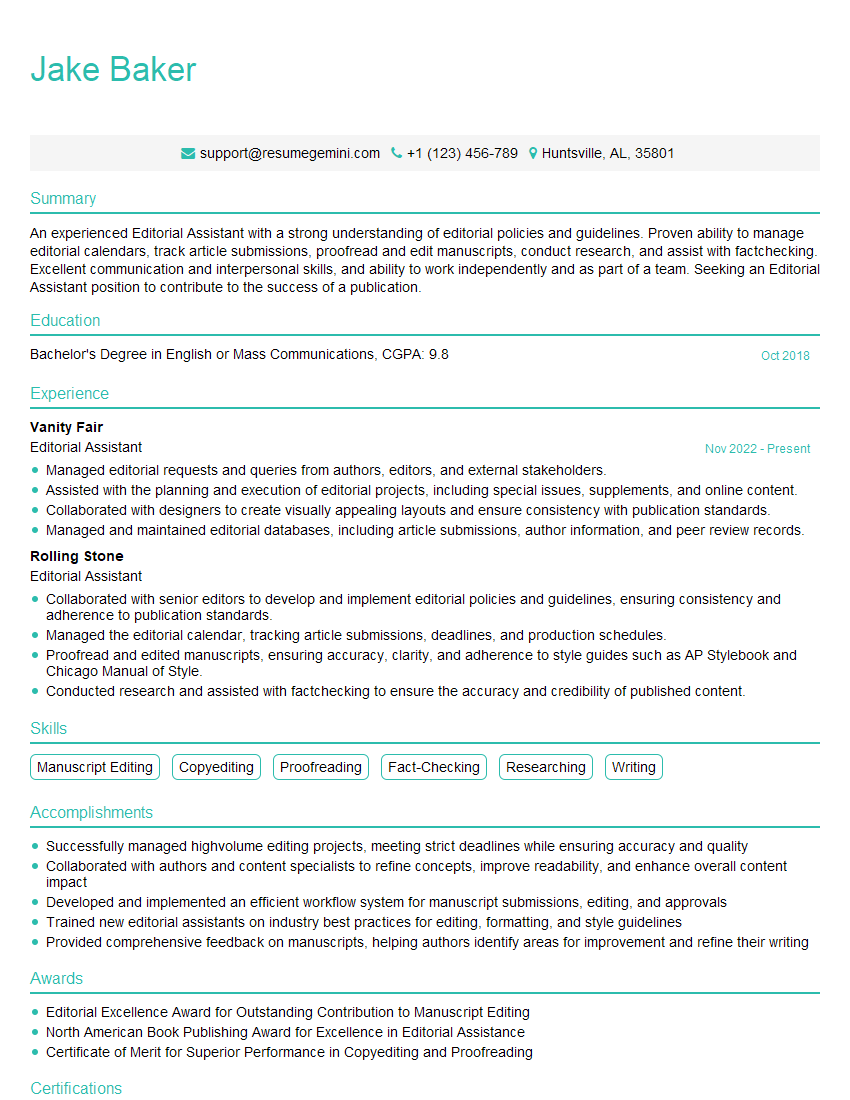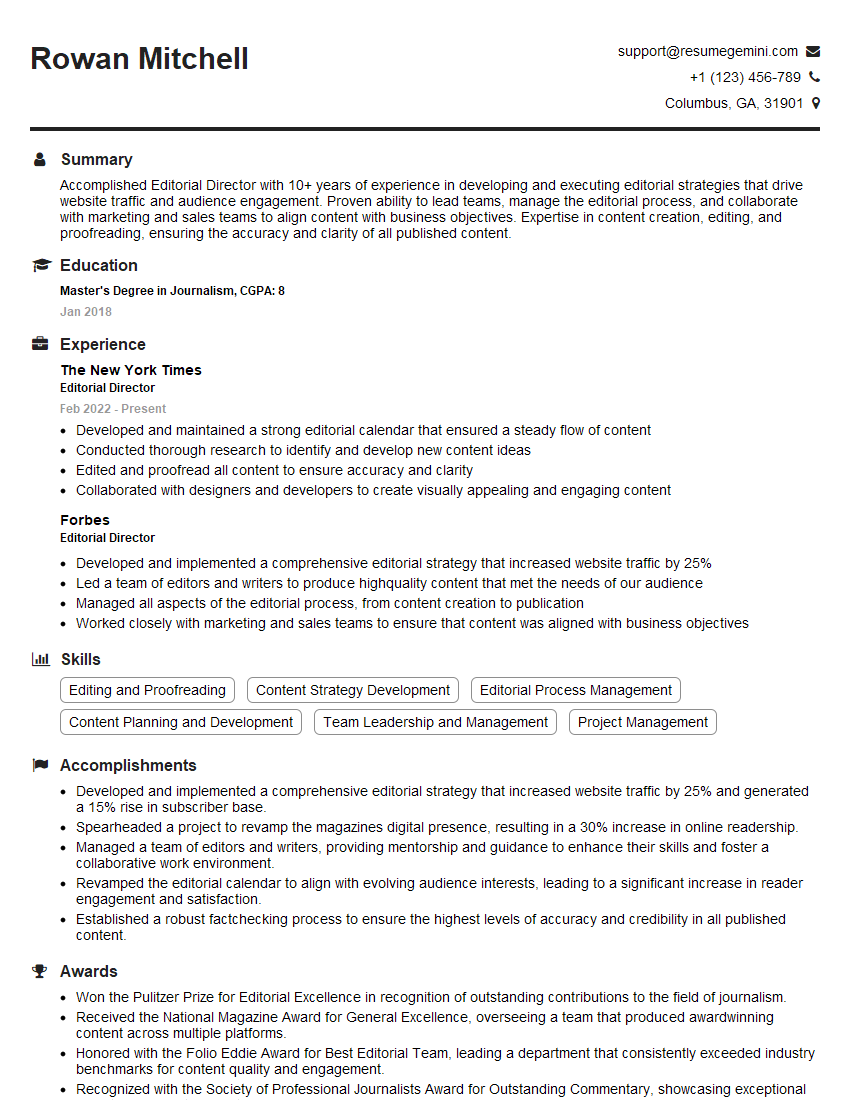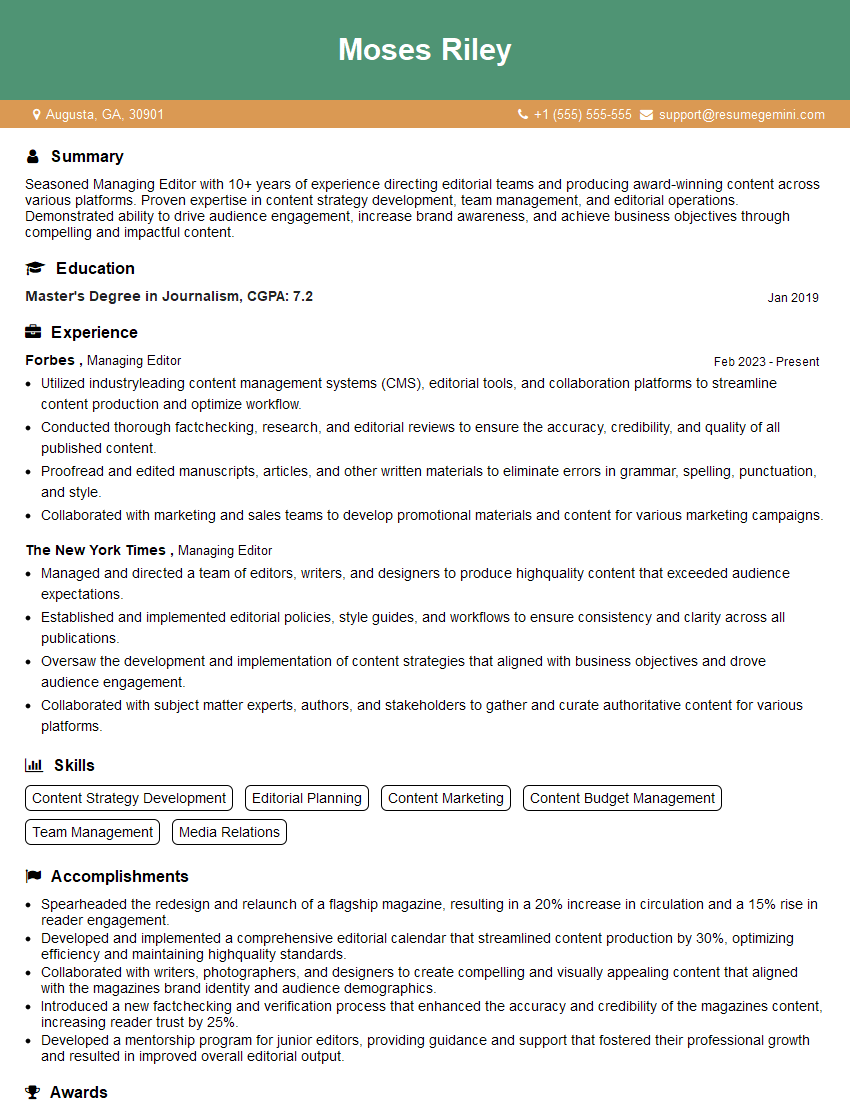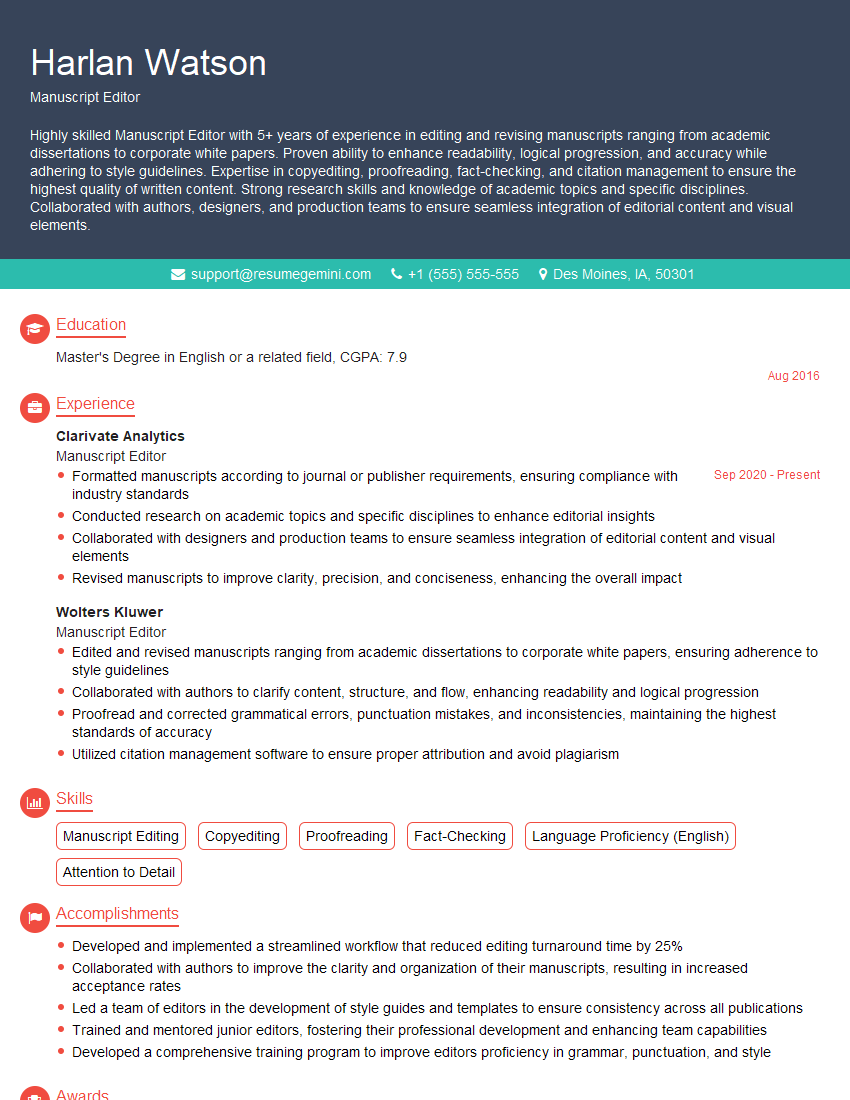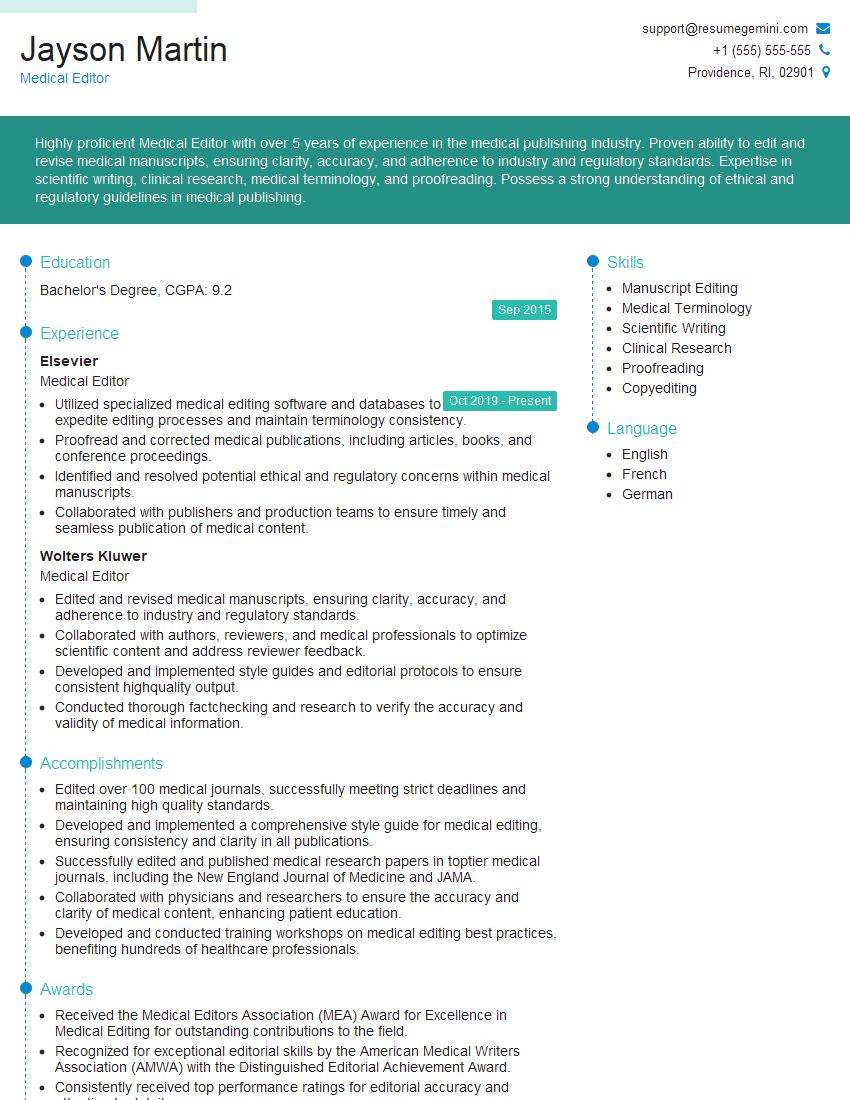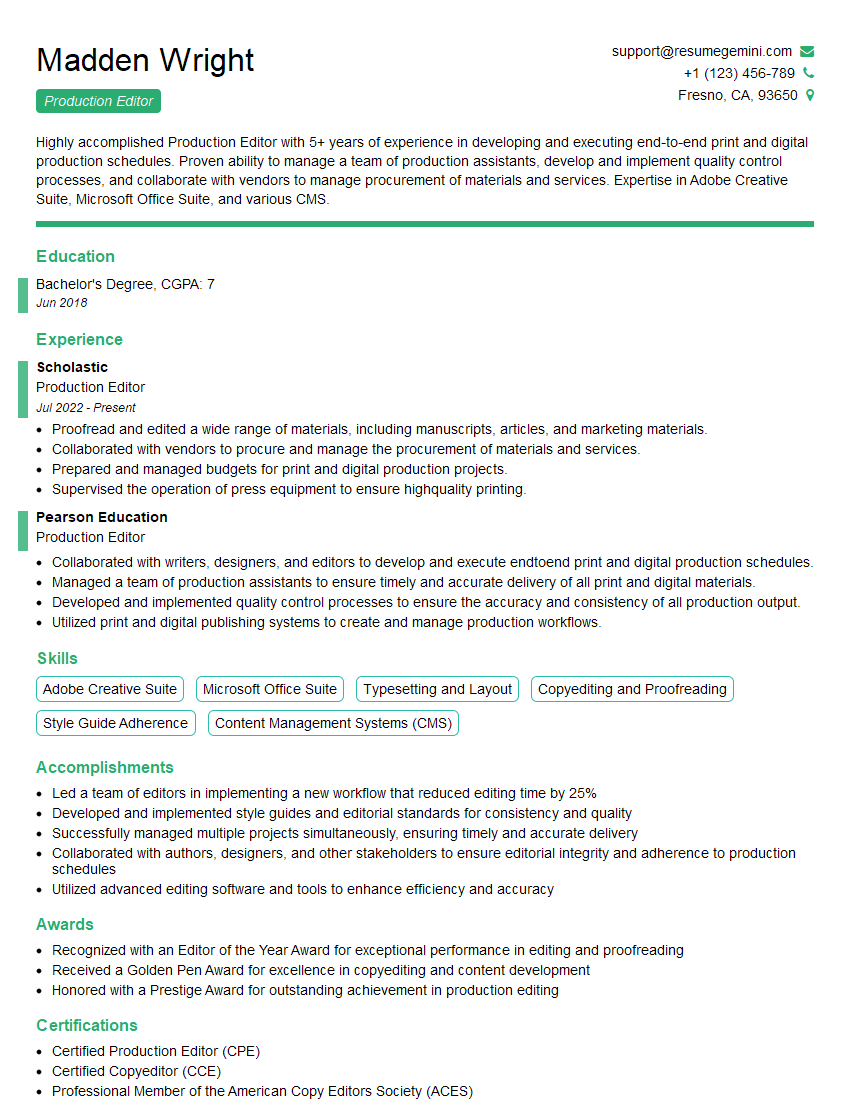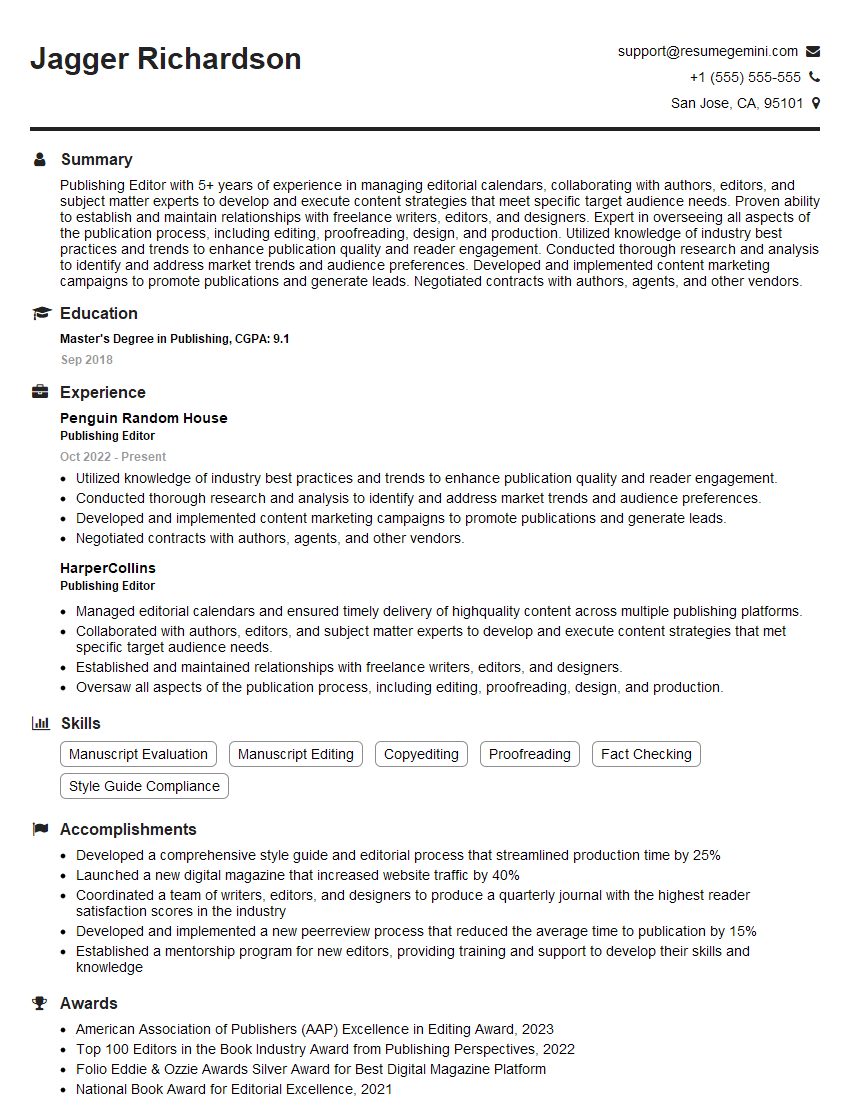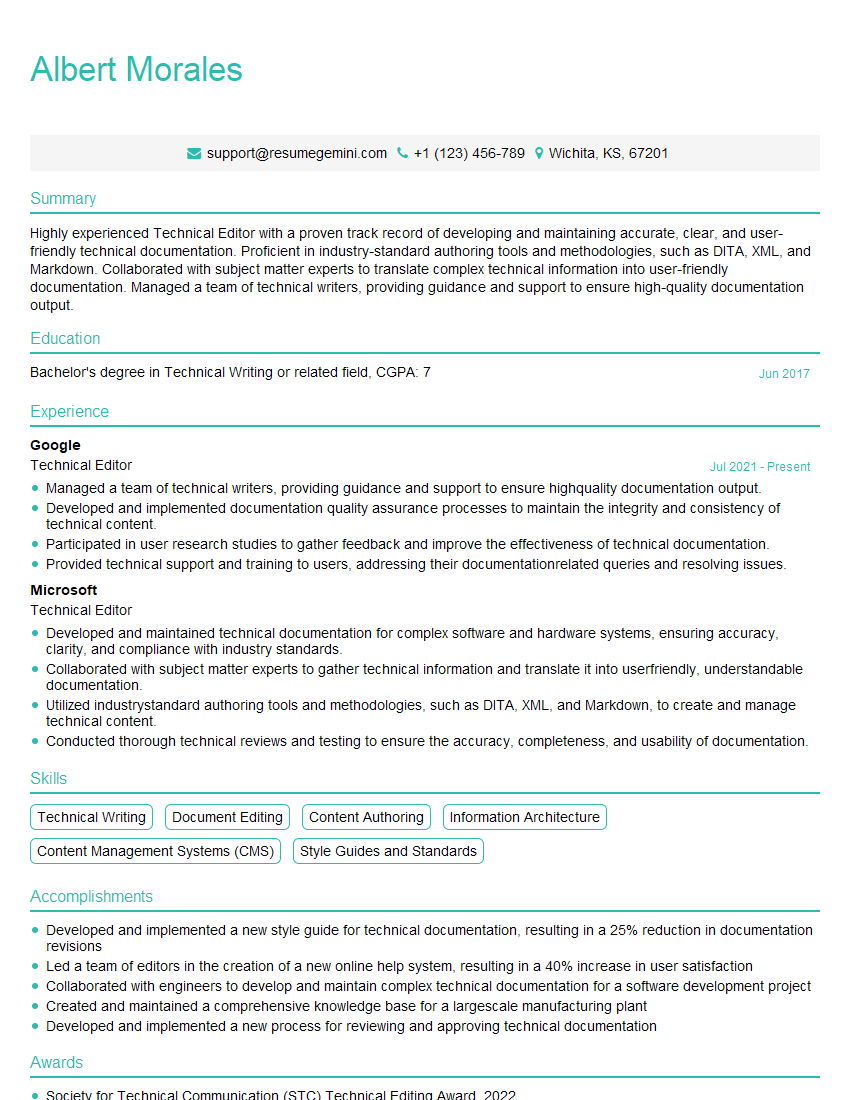Cracking a skill-specific interview, like one for Scientific Publishing and Editing, requires understanding the nuances of the role. In this blog, we present the questions you’re most likely to encounter, along with insights into how to answer them effectively. Let’s ensure you’re ready to make a strong impression.
Questions Asked in Scientific Publishing and Editing Interview
Q 1. Explain the difference between copyediting and proofreading.
Copyediting and proofreading are both crucial stages in the publication process, but they focus on different aspects of manuscript refinement. Think of copyediting as the deep clean and proofreading as the final polish.
Copyediting is a comprehensive review that addresses content, style, grammar, clarity, and consistency. A copyeditor ensures the manuscript flows logically, uses appropriate terminology, adheres to the chosen style guide (e.g., APA, Chicago), and is free of grammatical errors and inconsistencies. They might restructure sentences, suggest word choices, and check for factual accuracy within their scope. For example, a copyeditor might change a passive sentence like “The experiment was conducted by the researchers” to the more active “The researchers conducted the experiment.” They might also standardize the formatting of references or ensure consistent use of abbreviations.
Proofreading, on the other hand, is the final check for typographical errors, spelling mistakes, punctuation issues, and inconsistencies in formatting. It’s a meticulous review focused on the visual presentation of the text after copyediting is complete. A proofreader will not typically rewrite sentences or make substantial changes to the content; their focus is entirely on the surface-level accuracy of the manuscript before publication.
In short: copyediting focuses on content and style, while proofreading focuses on accuracy and presentation. Both are essential for producing a high-quality publication.
Q 2. Describe your experience with style guides (e.g., AMA, Chicago, APA).
I have extensive experience working with various style guides, including the American Medical Association (AMA), Chicago Manual of Style, and the American Psychological Association (APA) style guides. My familiarity extends beyond simply knowing the rules; I understand the rationale behind them and can adapt my approach depending on the target journal or publisher’s specific requirements.
For instance, while all three guides address in-text citations and reference lists, their formats differ significantly. The AMA style is particularly common in medical and health sciences publications, emphasizing brevity and clarity in citations. The Chicago style offers flexibility, catering to different disciplines and publication types, often favoring a more detailed approach to footnotes. The APA style is widely used in social sciences and behavioral sciences, with a focus on author-date citation systems. I can seamlessly switch between these styles, ensuring consistency and accuracy throughout the manuscript.
Beyond the core rules, I’m adept at navigating specific journal requirements, which often involve nuances and deviations from the standard style guide. I can adapt and integrate these requirements into my editing process to guarantee adherence to the publisher’s standards.
Q 3. How do you handle conflicting author requests regarding manuscript revisions?
Handling conflicting author requests during manuscript revisions requires tact, diplomacy, and a strong understanding of the scientific process. My approach involves:
- Facilitating Communication: I start by encouraging open communication among authors. I might schedule a call or facilitate an email exchange to help authors articulate their perspectives and find common ground.
- Prioritizing Scientific Rigor: Ultimately, scientific accuracy and integrity must prevail. If the conflicting requests contradict established scientific principles or methods, I would diplomatically explain the issue and advocate for the approach that aligns with best practices. I’d always offer evidence to support my recommendation.
- Suggesting Compromises: Many conflicts arise from minor stylistic disagreements or differing preferences. I’ll present alternative solutions and suggest compromises that incorporate the best elements of both author’s requests.
- Documenting Decisions: I meticulously document all changes and the rationale behind them. This ensures transparency and accountability. A clear record minimizes future misunderstandings or disputes.
- Escalating when Necessary: In rare instances where authors cannot reach consensus, I would escalate the issue to the editor-in-chief or designated authority, providing a clear and impartial account of the situation.
My goal is to navigate these conflicts constructively, preserving author collaboration and ensuring the quality and integrity of the manuscript.
Q 4. What is your approach to fact-checking scientific claims in a manuscript?
Fact-checking scientific claims is a critical aspect of my role. My approach involves a multi-step process:
- Identifying Claims: I carefully read the manuscript, identifying all claims that require verification, including statistics, experimental results, and interpretations of data.
- Consulting Primary Sources: I prioritize consulting primary sources—the original research papers and data sets—whenever possible. This ensures the accuracy and validity of the information.
- Using Reputable Databases: For information not directly available in primary sources, I utilize reputable scientific databases and resources (like PubMed, Web of Science) to verify information.
- Cross-referencing Information: I compare the claims in the manuscript to multiple sources to avoid reliance on single sources that might be biased or inaccurate.
- Querying Authors: If I encounter discrepancies or ambiguities, I promptly query the authors for clarification or additional data. This collaborative approach ensures accuracy while maintaining respectful communication.
- Documenting Fact-Checks: I maintain detailed records of my fact-checking process, including sources consulted and any corrections made. This transparency is vital for accountability and traceability.
Fact-checking is not about questioning the authors’ findings; rather it’s about ensuring the integrity and accuracy of the presentation of those findings in the manuscript.
Q 5. How familiar are you with plagiarism detection software and procedures?
I am very familiar with plagiarism detection software and procedures. I have extensive experience using various software programs such as Turnitin, iThenticate, and CrossCheck. I understand that these tools are not perfect and should be used judiciously in conjunction with careful manual review. Simply relying on software alone is insufficient.
My approach incorporates:
- Understanding Software Limitations: I recognize that software might flag instances of legitimate self-citation or common phrasing, so I carefully review all flagged passages. Context is crucial.
- Manual Review: Software-detected similarities are always reviewed manually to assess their context and determine if they constitute plagiarism. This involves analyzing the flagged text in relation to the original sources.
- Adherence to Best Practices: I adhere to established guidelines and procedures for plagiarism detection and reporting, ensuring transparency and fairness.
- Reporting Findings: If plagiarism is detected, I prepare a detailed report that identifies the instances, explains the context, and outlines appropriate corrective measures.
My goal is to maintain the highest standards of academic integrity through a combination of automated tools and thorough, human-driven analysis.
Q 6. Describe your experience with manuscript tracking systems.
I possess extensive experience with various manuscript tracking systems, including Editorial Manager, ScholarOne, and others. My familiarity extends beyond basic submission and tracking; I understand how to efficiently utilize these systems to manage the review process, communicate with authors and editors, and ensure timely completion of tasks. This includes uploading revised versions, tracking the progress of peer reviews, and monitoring deadlines.
For example, I am proficient in using these systems to:
- Organize Files and Materials: I effectively manage all relevant files and materials within the system, ensuring that everything is readily available to authors and editors.
- Communicate with Stakeholders: I utilize the system’s communication features to efficiently exchange information with authors, editors, and reviewers, maintaining clear and professional interactions.
- Monitor Deadlines and Progress: I leverage the tracking capabilities of the system to monitor deadlines, manage workflows, and proactively address any potential delays.
- Generate Reports: I can generate reports to monitor the overall progress and efficiency of the publication process.
My experience ensures efficient management of manuscripts throughout the publication workflow.
Q 7. How would you handle a delay in the publication process?
Handling delays in the publication process requires proactive communication and problem-solving. My approach includes:
- Identifying the Cause: I start by determining the root cause of the delay. This could range from slow peer review, author revisions taking longer than expected, to technical issues with the publishing platform.
- Proactive Communication: I immediately communicate the delay to all stakeholders (authors, editors, and potentially readers if the delay is significant). Transparency is key to managing expectations.
- Developing Solutions: I collaboratively work to develop solutions to address the cause of the delay. This might involve actively following up with reviewers, gently reminding authors of deadlines, or coordinating with the publishing team to resolve any technical issues.
- Managing Expectations: I communicate realistic timelines and expectations to all parties involved. I ensure that everyone understands the situation and the steps being taken to resolve it.
- Documenting the Delay and Resolution: I meticulously document the delay, its cause, the actions taken to resolve it, and the outcome. This comprehensive record helps to avoid similar delays in the future.
My goal is to minimize the impact of delays and maintain a smooth and efficient publication process, keeping everyone informed and engaged.
Q 8. Explain your experience with peer review processes.
Peer review is the cornerstone of scientific publishing, ensuring quality and validity. My experience encompasses all stages, from initial manuscript submission to final acceptance. I’ve served as both a reviewer and an editor, evaluating research across various disciplines. As a reviewer, I meticulously assess methodology, data analysis, and conclusions, providing constructive feedback to authors. My editorial role involves managing the review process, coordinating communication between authors and reviewers, and ensuring that reviews are fair, thorough, and unbiased. For instance, I recently reviewed a manuscript on climate change modeling. I identified several weaknesses in their statistical analysis and suggested improvements, which ultimately strengthened the paper’s conclusions. As an editor, I’ve managed reviews for over 50 manuscripts, leading to the publication of high-quality research.
I understand the importance of adhering to ethical guidelines during the peer-review process, such as maintaining confidentiality and avoiding conflicts of interest. My approach prioritizes both constructive criticism and the overall advancement of scientific knowledge.
Q 9. How do you prioritize tasks in a fast-paced publishing environment?
In a fast-paced publishing environment, prioritization is key. I employ a system that combines urgency and importance. I utilize project management tools to track deadlines, and I often employ a modified Eisenhower Matrix (Urgent/Important). Tasks categorized as urgent and important receive immediate attention; these might include copy-editing a manuscript nearing its publication date or addressing a critical author query. Important but not urgent tasks, such as developing style guides or updating editorial policies, are scheduled proactively. Urgent but not important tasks – like addressing minor formatting issues – may be delegated or deferred if possible. Finally, tasks that are neither urgent nor important are typically eliminated or postponed. This structured approach helps maintain efficiency and ensures that the most crucial work always takes precedence.
Regularly reviewing and adjusting this prioritization is crucial, as deadlines and unforeseen events can necessitate shifting focus. Flexible adaptation is a skill I’ve honed in this dynamic field.
Q 10. How do you ensure the accuracy and consistency of data in published research?
Ensuring data accuracy and consistency is paramount in scientific publishing. My approach involves a multi-layered strategy. First, a thorough review of the manuscript itself; I check for inconsistencies within the text and between the text and figures/tables. Next, I verify the statistical analysis, using appropriate software or consultation with experts when needed. This might include examining p-values, confidence intervals, or other relevant statistical measures. I also carefully examine all figures and tables, cross-referencing data presented visually with the data reported in the text. Discrepancies are flagged and addressed with the authors.
Furthermore, I encourage authors to provide supplementary materials (datasets, code), which allows for independent verification of their findings. Finally, I’m very familiar with plagiarism detection software and utilize it to ensure the originality of all submissions. A rigorous approach to data verification builds trust and upholds the integrity of the published research.
Q 11. What are your strategies for improving the clarity and readability of scientific writing?
Improving clarity and readability of scientific writing involves several key strategies. Firstly, I emphasize active voice and concise sentence structure. Passive voice often obscures the actor and can lead to cumbersome phrasing. For example, ‘The experiment was conducted by the researchers’ is less clear than ‘The researchers conducted the experiment’.
Secondly, I promote the use of plain language, avoiding jargon wherever possible. If specialized terms are unavoidable, they are clearly defined. Thirdly, I focus on logical flow and organization; using clear headings, subheadings, and transitions to guide the reader. A well-structured manuscript enhances comprehension. Finally, I encourage the use of visual aids such as figures and tables to summarize complex data and improve understanding. My editing process involves actively working with authors to implement these strategies, resulting in manuscripts that are both accessible and scientifically sound.
Q 12. How do you identify and correct grammatical errors, typos, and inconsistencies?
Identifying and correcting errors is a crucial part of the editing process. I utilize a combination of manual review and software tools. Manual review allows me to catch nuanced errors that software might miss – including inconsistencies in terminology or style. I carefully proofread the text, paying attention to grammar, punctuation, spelling, and consistency of formatting. I often read the manuscript aloud to catch errors my eyes might miss.
Software tools such as grammar checkers and style checkers provide an additional layer of accuracy. However, I recognize that these tools are not infallible, and human judgment is always required to interpret the results. The process is iterative, involving several rounds of review and revision to ensure a polished final product. I also pay particular attention to consistency in citation style and referencing, ensuring adherence to the journal’s guidelines.
Q 13. Explain your familiarity with different publication formats (print, online, etc.).
My familiarity with publication formats extends across print, online, and other digital formats. I understand the technical specifications of each format, including page layout, image resolution, and accessibility requirements for online publication. For example, print publications often require specific margins and font sizes, whereas online publications may incorporate interactive elements, multimedia, and alternative formats like PDFs and ePub. I’ve worked with various publishing platforms and systems, adapting to the specific requirements of each one.
I’m proficient in preparing manuscripts for different output formats, ensuring the final product is both visually appealing and technically sound. Understanding the nuances of different formats is essential for effective communication and reaching a wider audience.
Q 14. Describe your experience with image editing and figure preparation.
I possess significant experience with image editing and figure preparation, using software such as Adobe Photoshop and Illustrator. This involves ensuring figures are high-resolution, properly labeled, and consistent with the journal’s guidelines. My work includes improving image clarity, adjusting contrast and brightness, and removing artifacts or blemishes. I also create and edit graphs and charts, ensuring they are accurate, easy to interpret, and visually appealing.
I’m adept at preparing figures for various publication formats, considering factors such as resolution, color space, and file size. Furthermore, I carefully review figure legends and captions to ensure they are clear, concise, and accurate. Attention to detail in this area is crucial for effective scientific communication and avoids ambiguity.
Q 15. How do you work with authors to address reviewer comments and concerns?
Responding to reviewer comments is a crucial part of the publication process. It’s not just about fixing errors; it’s about engaging in a scholarly conversation and improving the manuscript’s quality and clarity. My approach is collaborative and iterative.
- Understanding the Comments: I start by carefully reviewing all comments, categorizing them by type (e.g., major revisions, minor edits, suggestions). I create a summary document for the author, highlighting key concerns and ensuring they understand the reviewers’ perspectives. This usually involves explaining any technical jargon reviewers may have used.
- Strategic Response: We then discuss each comment individually. For major revisions, we determine the best strategy to address the concerns, whether it involves adding new data, modifying the methodology, or restructuring arguments. For minor edits, we implement changes directly, ensuring consistent style and accuracy.
- Author Input: I always involve the authors in this process. We discuss the best way to incorporate changes and respond to criticisms, making sure the author’s voice and original intent are preserved. The goal isn’t merely to satisfy the reviewers but also to produce a stronger, more robust manuscript.
- Revised Manuscript: Finally, we create a point-by-point response to the reviewers, addressing each comment individually and justifying any decisions made. This response is crucial, as it shows the reviewers that their input has been carefully considered.
For example, if a reviewer suggests adding statistical analysis, I’ll work with the author to determine the appropriate tests, conduct the analysis (if necessary), and integrate the results into the manuscript and response document. I am proficient in various statistical software packages to facilitate this.
Career Expert Tips:
- Ace those interviews! Prepare effectively by reviewing the Top 50 Most Common Interview Questions on ResumeGemini.
- Navigate your job search with confidence! Explore a wide range of Career Tips on ResumeGemini. Learn about common challenges and recommendations to overcome them.
- Craft the perfect resume! Master the Art of Resume Writing with ResumeGemini’s guide. Showcase your unique qualifications and achievements effectively.
- Don’t miss out on holiday savings! Build your dream resume with ResumeGemini’s ATS optimized templates.
Q 16. What is your experience with preparing manuscripts for submission?
My experience in preparing manuscripts for submission is extensive. I’ve handled manuscripts across diverse disciplines, from life sciences and engineering to humanities and social sciences. This involves more than just formatting; it encompasses a thorough review of the manuscript’s structure, style, and adherence to the target journal’s guidelines.
- Style and Formatting: I ensure consistent style throughout the manuscript, using the appropriate citation style (e.g., APA, MLA, Chicago) and formatting according to the target journal’s instructions for authors. This often includes using tools like EndNote for reference management.
- Accuracy and Clarity: I meticulously check for grammatical errors, typos, inconsistencies in terminology, and clarity issues. I work with authors to ensure that the language is precise and that the message is conveyed effectively.
- Figure and Table Preparation: I assist with preparing figures and tables that are publication-ready, ensuring proper labeling, resolution, and formatting. This includes converting figures to the required file formats.
- Ethics and Compliance: I verify that all necessary permissions have been obtained for any copyrighted material and confirm the manuscript adheres to the journal’s ethical guidelines on authorship, data integrity, and conflict of interest.
Recently, I worked on a manuscript that required extensive revisions to its figures. The original figures lacked appropriate labeling and resolution. I worked with the authors to improve the figures, resulting in a clearer and more impactful manuscript that was eventually accepted for publication.
Q 17. How would you handle a situation where an author is unresponsive?
Unresponsive authors pose a significant challenge in the publication process. My approach is multifaceted and prioritizes communication and professional courtesy.
- Initial Contact: I would start by sending gentle reminders, checking if there are any technical issues or unforeseen circumstances that might be causing the delay.
- Escalation: If the lack of response continues, I would escalate the issue to the journal’s editor, providing documentation of my attempts to contact the author. The editor might then intervene directly, or we might consider alternative solutions such as finding a co-author to take on the responsibility.
- Documentation: Throughout the process, I maintain detailed records of all communications and actions taken, documenting the timeline and responses (or lack thereof). This documentation is crucial for transparency and accountability.
- Potential Withdrawal: In extreme cases where communication remains impossible, the journal may withdraw the manuscript from consideration. This is a last resort but necessary to protect the journal’s reputation and ensure timely processing of other submissions.
This situation highlights the importance of clear communication at the outset of the collaboration. Setting realistic timelines and establishing regular communication channels from the beginning is essential to avoid such issues.
Q 18. What software and tools are you proficient in (e.g., LaTeX, MS Word, EndNote)?
Proficiency in relevant software is essential for efficient and high-quality scientific publishing. My skillset includes:
- Microsoft Word: For comprehensive document editing, formatting, and track changes.
- LaTeX: For complex formatting, particularly for mathematical equations and scientific notations. I am familiar with various LaTeX packages for enhancing the visual appeal and structuring of documents.
- EndNote: For comprehensive reference management, ensuring consistent citation style and minimizing manual effort.
- Adobe Acrobat Pro: For PDF editing and manipulation, including handling of figures and annotations.
- Various Statistical Packages (e.g., R, SPSS, SAS): To help authors with data analysis and interpretation, as needed. My skillset also includes proficiency in graphical software such as GraphPad Prism for creating publication-quality figures.
I regularly update my skills to stay current with technological advancements in the field of scientific publishing.
Q 19. Explain your understanding of copyright and intellectual property rights in publishing.
Copyright and intellectual property rights (IPR) are fundamental aspects of publishing. They protect authors’ creative works and ensure their proper attribution and usage. My understanding encompasses various aspects:
- Author Rights: Authors typically retain copyright to their work, while granting the publisher certain rights, such as the right to publish and distribute the article. The specific rights granted are detailed in the copyright transfer agreement. The author retains the right to use the published work in other contexts.
- Publisher Rights: The publisher typically acquires the right to reproduce, distribute, and display the article. This enables the dissemination of research to a wider audience.
- Open Access: Open access publishing models involve various types of copyright licenses, often Creative Commons licenses, which allow for broader use and reuse of published articles while still providing attribution to the authors.
- Plagiarism and Copyright Infringement: I am vigilant about plagiarism and copyright infringement and utilize appropriate software to detect similarities between manuscripts. I ensure that all material used is properly cited and permissions are obtained where necessary.
A clear understanding of copyright is critical to ensure fair use and to protect both authors’ and publishers’ interests. I guide authors through the copyright transfer process, explaining the implications and answering any questions they might have.
Q 20. How do you ensure ethical publishing practices are followed?
Ethical publishing is paramount in maintaining the integrity of scientific research. My commitment to ethical practices encompasses several key areas:
- Authorship: I ensure that authorship is accurately assigned, reflecting the contributions of each individual involved in the research. Authorship disputes are addressed proactively.
- Data Integrity: I promote data transparency and reproducibility. I encourage authors to make their data available, while considering any necessary restrictions or privacy concerns.
- Conflict of Interest: I work with authors to identify and disclose any potential conflicts of interest, ensuring that these are appropriately managed and addressed in the manuscript.
- Plagiarism and Self-Plagiarism: I meticulously check manuscripts for plagiarism, using appropriate software and techniques. I also ensure that authors avoid self-plagiarism by appropriately citing their previous work.
- Image Manipulation: I am vigilant in detecting and addressing any inappropriate manipulation of images or figures. If necessary, I consult with image analysis experts for verification.
- Peer Review: I support and respect the integrity of the peer-review process, upholding the principles of confidentiality and objectivity.
Maintaining ethical publishing practices requires diligence and a thorough understanding of relevant guidelines. I continuously update my knowledge of best practices and relevant policies.
Q 21. What is your experience with indexing and abstracting databases?
Indexing and abstracting databases are crucial for the discoverability and impact of published research. My experience involves understanding the significance of these databases and their role in disseminating scientific knowledge.
- Understanding Databases: I am familiar with major indexing and abstracting databases such as PubMed, Scopus, Web of Science, and others. I understand their different scopes, indexing criteria, and impact factors.
- Metadata Preparation: I assist in preparing metadata for manuscripts, ensuring accurate and comprehensive information, including keywords, subject classifications, and other relevant identifiers. This increases the likelihood of the manuscript being indexed correctly and effectively.
- Database Submission: I am knowledgeable about the procedures for submitting manuscripts to these databases. I assist in formatting the manuscript appropriately and providing necessary metadata.
- Impact Factor Awareness: I understand the concept of impact factors and journal rankings and how these relate to the selection of appropriate journals for submission.
Successful indexing is essential for maximizing the reach of published research. By ensuring accurate and thorough metadata, we increase the chances that the research will be discovered by the appropriate audience.
Q 22. Describe your experience with preparing supplementary materials for publication.
Preparing supplementary materials is crucial for enhancing the accessibility and impact of scientific publications. It involves creating additional resources that provide more detailed information or context than the main manuscript allows. This might include large datasets, extended methods, high-resolution images, videos, or interactive simulations.
- Datasets: I have extensive experience managing and preparing large datasets for online repositories like Figshare or Dryad. This involves proper formatting (e.g., CSV, TXT, or specialized formats), creating clear metadata descriptions, and ensuring data integrity and accessibility for others to replicate the study’s findings.
- Extended Methods: Detailed explanations of complex experimental procedures, statistical analyses, or modeling techniques often find their place in supplementary materials. I’ve worked on several projects where I’ve refined lengthy methodological descriptions, transforming them into clear, concise, and well-structured supplementary sections, using numbered steps or subsections for improved readability.
- Multimedia: I’ve helped prepare high-resolution images and videos for online publication, optimizing them for different platforms while maintaining scientific accuracy and visual appeal. This involves ensuring proper file formats, resolutions, and captions.
For example, in a recent project involving genomic data analysis, I prepared a supplementary file containing all raw sequence data, the annotated genome, and detailed scripts used for the analysis. This allowed complete transparency and reproducibility of the study’s findings.
Q 23. How familiar are you with open access publishing models?
I’m very familiar with various open access publishing models. These models differ primarily in how they fund the open access publication of scholarly work. The two most prevalent models are:
- Author-pays (APC): In this model, the authors or their institutions cover the publication fees. I have experience helping authors navigate the process of applying for APC waivers or grants to support open access publication. Understanding the nuances of different APC structures is essential for effective budget planning.
- Read-and-publish (Institutional Subscriptions): Here, institutions pay a subscription to a publisher, granting their affiliated researchers open access publishing rights. I understand the benefits and drawbacks of this model compared to the APC model, especially considering factors like institutional resource constraints and the potential for disparities in access for authors affiliated with different institutions.
Beyond these core models, there are also hybrid models where some articles are open access while others remain behind a paywall, and fully open-access journals with no paywalls, often funded through alternative means like grants or institutional subsidies. My experience spans all these models, enabling me to advise authors on the most suitable options based on their funding and publication goals.
Q 24. How do you manage the production process of a journal or book?
Managing the production process of a journal or book involves a multi-stage workflow that requires meticulous planning and coordination. It begins with manuscript acquisition and peer review, and culminates in publication and dissemination.
- Manuscript Handling: This includes managing submissions, assigning reviewers, tracking progress, and ensuring timely feedback. Tools like editorial management systems (EMS) are essential for efficient handling.
- Copyediting and Proofreading: This is a critical stage ensuring consistency in style, grammar, and accuracy. I’m proficient in using style guides (e.g., AMA, APA, Chicago) and employing quality control measures to maintain high editorial standards.
- Typesetting and Layout: This involves converting edited manuscripts into a publication-ready format, following specific style guidelines and ensuring optimal readability.
- Production and Printing/Online Publication: This stage covers aspects like file preparation for online publication (e.g., PDF/XML), coordinating with printers (if applicable), and ensuring timely online publication or print delivery.
I use project management tools and communication strategies to ensure smooth collaboration among authors, editors, typesetters, and other stakeholders throughout the entire production pipeline. Effective communication and proactive problem-solving are vital in managing the diverse elements of this complex process.
Q 25. What is your experience with preparing budgets for publishing projects?
Budget preparation for publishing projects requires a detailed understanding of all associated costs. This includes:
- Author fees: APCs, if applicable.
- Editorial fees: Costs related to copyediting, proofreading, typesetting, and other editorial services.
- Production fees: Costs for printing, binding, and distribution (if applicable).
- Marketing and promotion: Costs associated with advertising and disseminating the publication.
- Open access fees (if applicable): Costs associated with making the publication openly accessible online.
I have experience developing detailed budgets, including contingency planning, using spreadsheet software to track expenses and revenue projections. I understand the importance of providing transparent and realistic budget estimates to secure funding and manage resources effectively. For example, when working on a book project, I created a detailed spreadsheet that accurately forecasted costs and facilitated effective communication with the funder about potential expenses and revenue.
Q 26. How do you stay up-to-date with best practices in scientific publishing?
Staying current with best practices in scientific publishing is a continuous process. My strategy involves a multi-faceted approach:
- Professional Organizations: Active membership in organizations such as the Council of Science Editors (CSE) or the International Association of Scientific, Technical, and Medical Publishers (STM) keeps me informed about evolving standards and guidelines.
- Conferences and Workshops: Attending conferences and workshops provides opportunities to network with peers and learn about emerging trends and technologies in publishing.
- Journals and Publications: Reading industry publications, such as the Scholarly Publishing and Academic Resources Coalition (SPARC) reports or the STM newsletter, helps me stay abreast of significant developments and policy changes.
- Online Resources: Staying updated through websites of relevant organizations and online communities, utilizing resources like PubMed, and following key thought leaders on social media platforms enables me to continuously expand my knowledge base.
Furthermore, I actively participate in online forums and discussions related to scientific publishing, which allow for ongoing engagement with industry professionals and the exchange of best practices.
Q 27. Describe your experience with metadata creation and management.
Metadata creation and management are crucial for discoverability and efficient organization of scholarly information. This involves creating structured data elements that describe the content and context of a publication.
- Dublin Core Metadata: I have experience applying Dublin Core elements such as title, author, subject, and publication date to various digital publications and data sets. Understanding how to use these elements effectively increases the likelihood that the work will be discovered via search engines and other discovery tools.
- Schema.org Markup: For enhanced online visibility, I utilize schema.org vocabulary to enrich website content with structured metadata that helps search engines accurately index and classify content.
- Data Citation: I’m proficient in creating and managing metadata for research datasets, ensuring that datasets are properly cited and credited using standards like DataCite.
- Metadata Standards: I am also familiar with other metadata schemas relevant to scientific publishing, such as those used by various repositories and databases, ensuring interoperability and accessibility.
For example, when preparing a dataset for publication on a repository like Dryad, I meticulously created metadata including detailed descriptions of the data, methodology, variables, and relevant keywords to facilitate its proper indexing and discovery.
Key Topics to Learn for Scientific Publishing and Editing Interview
- Manuscript Preparation and Submission: Understanding the entire publication process, from initial manuscript review to final publication, including author guidelines and ethical considerations.
- Copyediting and Proofreading: Practical application of grammar, style guides (e.g., AMA, Chicago), and punctuation rules to ensure accuracy and clarity in scientific documents. This includes identifying and correcting errors in spelling, grammar, punctuation, and style inconsistencies.
- Structural Editing: Improving the overall organization, flow, and clarity of a manuscript, ensuring logical progression of arguments and effective communication of scientific findings.
- Fact-Checking and Verification: Developing skills in verifying data, references, and figures for accuracy and completeness. This involves cross-referencing sources and detecting potential plagiarism.
- Working with Authors and Editors: Understanding the dynamics of collaborative work, effective communication strategies, and conflict resolution techniques in a professional setting.
- Publication Ethics and Best Practices: Familiarity with ethical considerations in scientific publishing, such as plagiarism, authorship disputes, and data manipulation. Understanding policies on conflicts of interest and research integrity.
- Typesetting and Layout: Basic understanding of the technical aspects of document production, including formatting, layout, and image preparation for print and online publication.
- Indexing and Metadata: Knowledge of indexing techniques and the importance of accurate metadata for discoverability and searchability of published works.
- Digital Publishing and Open Access: Understanding the evolving landscape of scientific publishing, including trends in digital publishing, open access models, and online platforms.
- Copyright and Intellectual Property: Understanding the legal aspects of copyright and intellectual property rights in the context of scientific publishing.
Next Steps
Mastering Scientific Publishing and Editing opens doors to a rewarding career with diverse opportunities for growth within academia, industry, and government. A strong understanding of these skills is highly sought after, making you a competitive candidate in a rapidly evolving field. To significantly boost your job prospects, create an ATS-friendly resume that effectively showcases your skills and experience. We highly recommend using ResumeGemini, a trusted resource for building professional and impactful resumes. ResumeGemini provides examples of resumes tailored specifically to the Scientific Publishing and Editing field to help guide you. Start building your resume today and let your expertise shine!
Explore more articles
Users Rating of Our Blogs
Share Your Experience
We value your feedback! Please rate our content and share your thoughts (optional).
What Readers Say About Our Blog
Live Rent Free!
https://bit.ly/LiveRentFREE
Interesting Article, I liked the depth of knowledge you’ve shared.
Helpful, thanks for sharing.
Hi, I represent a social media marketing agency and liked your blog
Hi, I represent an SEO company that specialises in getting you AI citations and higher rankings on Google. I’d like to offer you a 100% free SEO audit for your website. Would you be interested?
